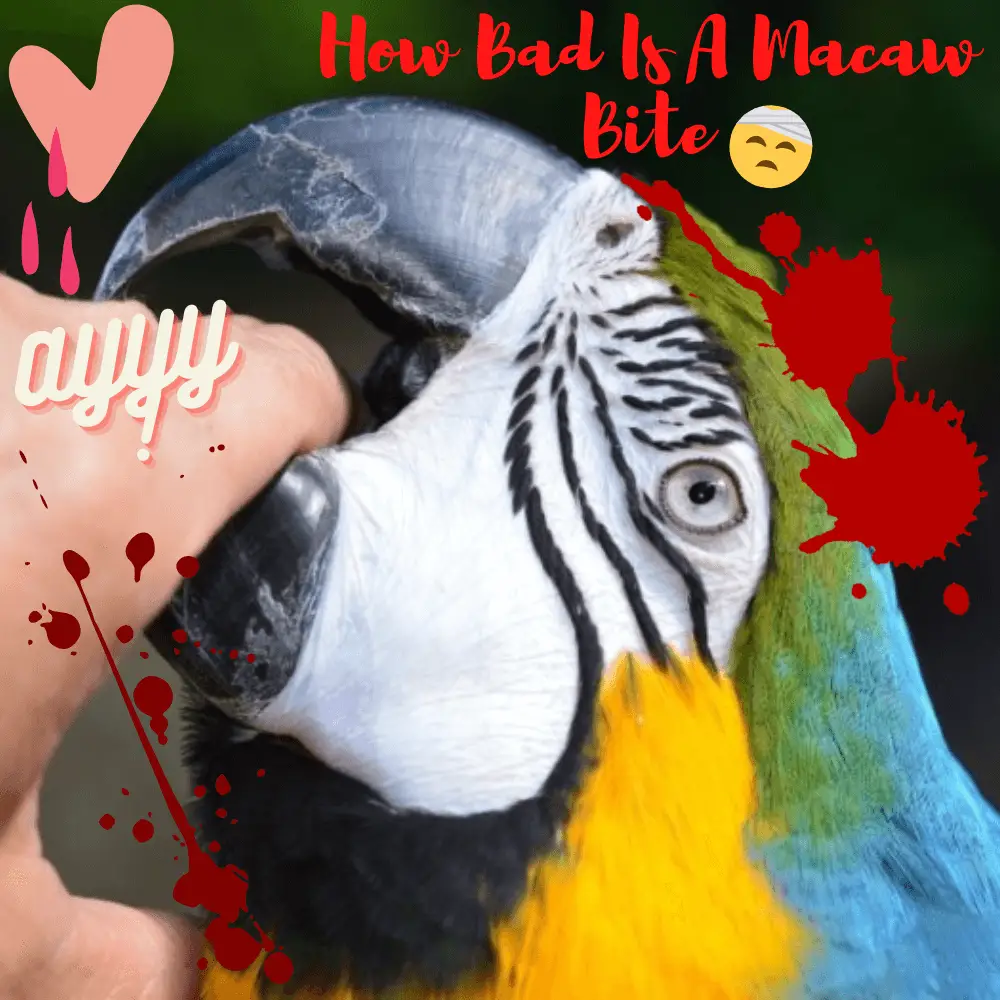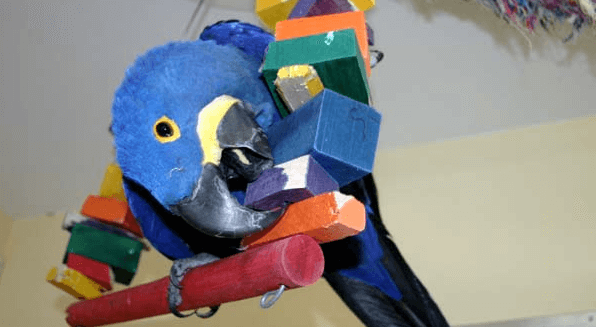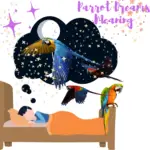
Parrots that bite, Can A Macaw Bite Your Finger Off? and How Bad Is A Macaw Parrot Bite? Losing a finger as a result of a parrot bite is about as painful as possible, and if you own or rub shoulders with parrots, you need to be on your guard.
The beak of a parrot is powerful and capable of inflicting a nasty bite. Remember that these same jaws can crush large tropical nuts with a powerful bite pressure of 300 to 1000 pounds per square inch depending on the breed. The bite force of the largest breeds of parrots is more than capable of biting a finger to the fullest!
Breeds of parrots that can bite a finger.
When considering the types of parrots that might bite your finger, macaws and cockatoos immediately come to mind. These parrots have powerful jaws and sometimes the desire and speed to grab an outstretched hand and not let go of it.
Most of the injuries suffered by these parrots do not directly amputate a finger, but the largest parrot species, such as the hyacinth macaw and the black cockatoo, are more than capable of providing this level of strength.
For example, a hyacinth macaw can bite through a broom handle. Watch how this Hyacinth tears a tree branch into pieces:
But even if you don’t lose a finger, a parrot bite can do serious damage.
A parrot bite injury to the hand is serious!
Medical experts are encountering more and more cases of parrots that bite, as exotic pets like parrots are becoming more common. Bite injuries to the fingers and hands caused by exotic animals like parrots can be serious, resulting in fractures or even amputation of an affected finger.
A British case study published in the medical journal HAND highlighted the severity and risks associated with a parrot bite.
The case involved the presentation to the emergency room of a 17-year-old British boy who had been bitten by a friend’s parrot while he was petting it. He said the parrot clung to his left index finger for a few seconds before releasing it.
Medical examination and X-rays revealed that he had suffered an open fracture of the phalanx, a type of severe fracture where the broken bone pierces or is exposed through the skin.
Not only did the young man have to undergo complete surgical debridement (cleaning) of the wound as well as stabilization and splint of the fracture, but he also had to take a series of powerful broad-spectrum antibiotics to combat germs potentially transmitted through a parrot bite.
A parrot bite is a dirty bite
You absolutely do not want to encounter the germs contained in the saliva of parrots, which can cause serious infections such as psittacosis or parrot fever:
- Psittacosis or parrot fever is a disease that can leave affected people with severe pneumonia and inflammation of the heart and brain.
- Pasteurellosis is another zoonosis that can cause local inflammation and tissue damage as well as sepsis.
- Mycobacteriosis can cause diseases of the soft tissues and lungs.
As with other animal bites, infections can be much worse than the physical damage caused by the bite. Infection and gangrene can also lead to the loss of an affected finger!
Macaw bite
Why do parrots bite?
As with other pet birds, the bite can be due to a variety of reasons and is usually an isolated but painful incident. If the bite is a recurring problem, there is usually an underlying cause.
The temperament of the parrot is an important factor in determining whether or not a parrot will attack your finger; some parrots are more aggressive or move easily. Parrots bite out of fear and often frustration. If they are bored or the size of the cage is too small and without parrot toys, they are more likely to bite.
In addition, the mating season is accompanied by increased tension and jealousy that can push even very docile parrots to bite. Diseases, injuries, and annual molting can also make a parrot irritable and susceptible to bite if approached in the wrong way.
Managing the bite in parrots
When dealing with intelligent and curious animals like parrots, you have to be very careful about how you deal with a tendency to bite.
Screams, sudden maneuvers, or any other drama around an attempted bite or an actual bite can only reinforce the biting behavior. Even if you feel like screaming, try to stay calm as much as possible.
Observe your parrot for underlying causes and don’t hesitate to call a veterinarian if it shows signs of disease. Also, examine his accommodation: is his cage too small, and are there too few toys or activities for him to keep busy?
Remember that parrots are social creatures and without proper interaction, they could let you know by biting you!
Parrots that bite

In short
Fortunately, the cases of missing musts! caused by an angry parrot is extremely rare.
However, it is important to remember that these are powerful birds with different personalities and temperaments. You need to get to know your parrot’s ways to encourage its best behavior and curb any tendency to bite before it becomes an unwanted habit.
Macaw Bite
SOURCE:Parrot Wizard
How to prevent a macaw from biting
Green-winged macaws are fun, interactive, and affectionate pets. Because they are very intelligent and social animals, macaws need a lot of exercise and stimulation. It is essential to create a positive and healthy relationship with your bird so that it feels like a member of the family. Providing a bird with a safe environment and trusting keepers will help prevent parrots that bite and aggression, and give you more time to focus on the fun tasks of teaching your bird language skills and various tricks.
Offer your birds treats on a spoon. It’s fine to give your bird a treat once it’s become more comfortable with you, but a biting bird can snatch treats or even bite the hand that feeds it. If you think your macaw could do this, offer the treat on a long, flat object like a wooden spoon to keep your hand at bay. Do not force the process of accepting treats – wait for your bird to come to you. Once the treatment is accepted, you can gently stroke your bird on the chest.
- The best treats for macaws are nuts, such as macadamia nuts, pecans, Yvelines, almonds, and walnuts.
Give your bird a balanced diet. A balanced diet consists of 85% granules, 5% varied seeds, and 10% fresh fruits and vegetables. Parrot mixes are available that combine formulated feed, seeds, dried feed, and nuts. Additional supplements, such as fresh fruits, vegetables, cooked chicken, and meat, are good ways to give your bird extra vitamins and protein.
-
Provide your bird with a large cage. Macaws are large birds that need a lot of exercises. Buy a cage that offers enough space for toys, several perches, and parrot food dishes, while leaving enough space for your bird to move freely.
- Bring elements of the natural world into the parrot cage. Try making perches with sticks and placing small branches with leaves in the cage to make your bird feel more comfortable.
- Also, give your bird time to get out of the cage. This will allow the macaw parrot to do much-needed exercise and stimulation. Place perches around the house, especially in areas where you or your family members tend to hang out, so your bird can feel socially engaged. Be sure to provide your bird with fresh drinking water every day
-
Teach your bird to rise. Getting your bird up on your hand is essential for any further training. Take it easy and make sure you smile and make eye contact while teaching your bird to rise. Macaws can read your body language and will know if you are stressed or frustrated.
- Start by putting a treat in one hand and place the other near the bird. The bird will probably go to get the treat. Give the treat and offer compliments. Then try again, this time asking your bird to stand up. Repeat this process until your bird is comfortable enough to intensify. Once the bird climbs with one foot, continue until it begins to use both feet.
Set up security zones. Once you start picking up your bird with your hands, it’s important to teach it a few limitations. Otherwise, you run the risk of letting your bird fly recklessly around the house, which can lead to injury or leakage.
- Start by taking your bird out of its cage. Whenever the bird tries to fly away, pick it up gently and place it on your shoulder, hand, or outside the cage. This allows the bird to know that these are acceptable landing zones.
- Once your bird has become familiar with its safe landing zones, let it fly a little more freely around the house. Be sure to monitor where your parrot lands. If it does not land in a prescribed safety zone, continue to place it back on your hand, shoulder, or cage until it no longer lands in unwanted places.
Listen to the clicking beak. If your bird snaps its beak several times in a row, you should consider this as a sign that your bird feels defensive, aggressive, or doesn’t want to be manipulated. Often, the snapping of the beak is accompanied by an elevation of one foot or stretching of the neck. Pay attention to the behavior of your bird. Attempting to play with your bird at this time can lead to a bite.
- A tongue snap, on the other hand, is a sign that your bird wants to play. Learn the difference between the mouthpiece and the clatter of the tongue and respond appropriately.
Parrots that bite






















